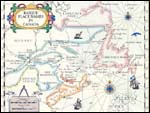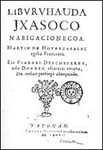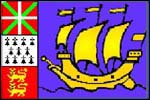 |
 |
 |
 |
 |
<< subjects
>> |
 |
 |
06.-
Basque Steps in the East
06.1
EAST AND WEST
Most Basque-Americans are found in the western states. California
has the highest population of Basques, as well as the highest number
of Basque clubs and restaurants. It is also where Basque cultural
activities are most visible. In relative terms, however, it is in
Idaho that one finds the greatest Basque presence. The Basque population
is only one third of what it is in California, however exceeding
one million, while in California it is around thirty-five million.
On the east coast there are Basque communities in New York, Washington
D.C., and Florida.
|
 |
 |
|
06.2
BASQUE FISHERMEN
In this context mention should be made of historical settlements
in Newfoundland and Labrador. Basque fishermen arrived for the first
time on the coast of Quebec and the Canada of today in search of
whales. Historians do not agree as to when. Some say they may have
been there before Columbus. Douglass and Bilbao refer to a literary
tradition of the 16th and 17th centuries that attributes the discovery
of the New World to the Basques. In any case it is clear that the
Basques have been fishing in the area from time immemorial. Gravestones
found in Placentia Bay, Newfoundland, dating from the 16th and 17th
centuries give testimony to such.
|
 |
06.3
THE "COAST OF THE BASQUES"
The western part of Newfoundland used to be known as "Côte
des Basques", and a certain number of place names along the coast
are of Basque origin. The fishing stations were described in 1677
by Pierres Detcheverry of Donibane Lohizune (St. Jean de Luz) in his
book Ixasoco Nabigacionecoa, which was translated into Euskara from
the French work published in 1578 by the Basque Martin de Hoyarzabal,
of Ziburu. |
 |
|
06.4
BASQUE NAMES IN CANADA
The name of the modern Port-Aux-Basques may be found as early as
1612 on the map of eastern Canada by Samuel de Chaplain. Whalers
and cod fishermen along the entire Basque coast (Baiona, Donibane
Lohizune, Ziburu, Hondarribia, Donostia, Mutriku, Ondarroa, Lekeitio,
Ea) knew the area well. Even today in Saint-Pierre and Miquelon
a Basque population and Basque festivities are found, with the colours
of the Basque ikurriña (flag) flying alongside other local
symbols. Currently about thirty percent of the people of Saint-Pierre
and Miquelon (islands offshore from Port-Aux-Basques, belonging
to France) are of Basque origin. In Saint-Pierre one can find the
Orok Bat Basque dancers. There is a club with a great pilotazale
tradition, its pilota court dating from 1906. On the route between
Europe and America, Iceland also knew Basque presence. In the 17th
century the inhabitants wrote two Basque-Icelandic glossaries, which
have survived.
|
 |
|
|
 |
 |
 |
|
|




